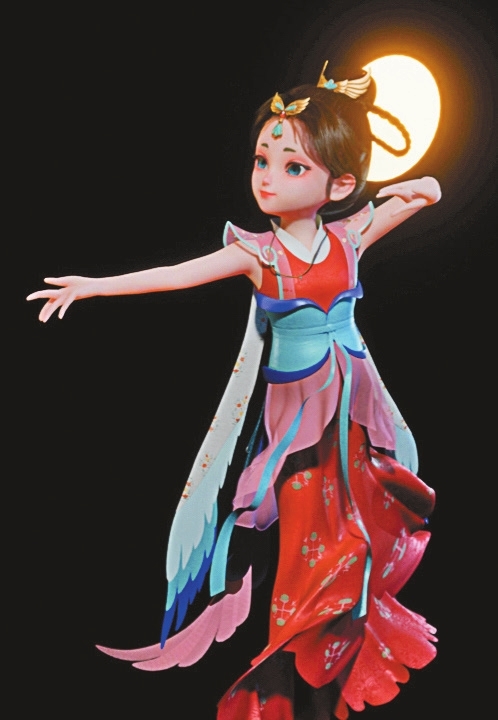
JIAYAO, a CGI figure of a dancer wearing traditional Chinese clothing, is helping popularize Buddhist art by inheriting dance moves that originated thousands of years ago. The little figure was inspired by the Flying Apsaras depicted in murals at the Mogao Grottoes in Dunhuang, a major treasure house of art and culture in Northwest China’s Gansu Province. Jiayao is the official virtual ambassador of the Mogao Grottoes which are home to 735 caves containing some of the finest examples of Buddhist art. Other digital technologies such as AI and motion capture have brought the virtual figure to life. She will meet the public through exhibition livestreams and franchise development. Jiayao is one of the Dunhuang Academy’s efforts to use digital technology to promote and conserve the cultural relics at the site. The academy and Tencent last week launched a digital laboratory to build a full-scale digital scripture cave of the Mogao Grottoes, sharing with the public the “fresh life” behind the cultural relics in an interactive experience. They will use laser scanning and photo reconstruction technology, combined with procedural content generation and rendering technologies, to restore the details of the Buddhist murals, statues and texts at the site, and simulate the lighting and vegetation of the Mogao Grottoes at different times, according to Tencent. The two parties signed a five-year strategic cooperation agreement. Based on the laboratory and using the game technology of Tencent Interactive Entertainment, they will jointly develop cultural and creative products and carry out in-depth cooperation in many fields. Among the many caves at the grottoes, one cave containing an important cache of documents was discovered in 1900. The “Library Cave” is one of the most important parts of the digitalization project being carried out by the Dunhuang Academy and Tencent. The cave was one of the greatest archaeological discoveries of the 20th century in China. It contains more than 60,000 cultural relics ranging from the 4th to 11th centuries, including scriptures, documents and silk paintings. However, due to historical reasons, these precious cultural relics have been scattered all over the world, and most people have no chance to see their true colors. The first cultural relic that will soon enter the public eye in the virtual world is a national first-class cultural relic: an account book dating to the Song Dynasty (960-1279). This book provides insight into the economy, culture, calendar and folk customs of Dunhuang at that time. The Dunhuang Mogao Grottoes are a 1,600-year-old UNESCO world heritage site. Located at a cultural and religious crossroad on the ancient Silk Road, they are also known as the Thousand Buddha Grottoes. With the rapid development of the digital economy, more technology companies and cultural institutions have joined hands to introduce cutting-edge digital technologies to explore new forms of cultural protection. A digital interactive space featuring new archeological discoveries at the Sanxingdui Ruins has also been launched at the site in Sichuan Province. Entering the digital space, visitors can immerse themselves in the ancient Shu Kingdom as they explore a digital museum and the excavation site. While the cultural relics found in Sanxingdui Pit No. 5 have been packed and shipped to a cultural protection center, leaving the pit empty, in the digital interactive space, people can explore the pit before it was excavated. For instance, fine pieces of gold can be seen scattered around the pit. Ding Daoshi, a veteran independent analyst in the internet sector, noted that digital technology must continue to improve as current technology can easily recreate the outer appearance of an object, but it is difficult to record the detailed inner structure of the objects. Efforts to digitize China’s heritage have been carried out for years. Yu Tianxiu, director of the Dunhuang Academy’s Cultural Relics Digitization Department, said the grottoes’ earliest digitization efforts began in the early 1990s. In May, the Central Committee of the Communist Party of China and the State Council released guidelines on developing the country’s national cultural digitization strategy. The guidelines noted that by 2035, a national cultural big data system will be established with the aim of comprehensively presenting Chinese culture and allowing people to access the results of digital cultural research. (Global Times) | 
